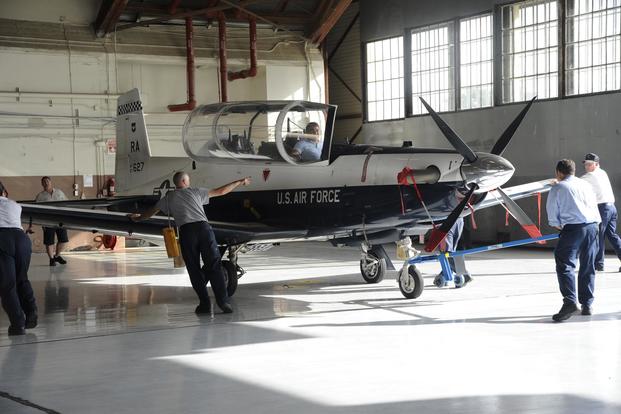U.S. Air Force T-6 Texan trainer jet operations took a brief pause at Randolph Air Force Base, Texas, last week after it was reported pilots were concerned about the aircraft's on-board oxygen generating systems.
"The 559th Training Squadron commander at Joint Base San Antonio-Randolph resumed normal flying operations on the morning of June 26 after a brief pause on the afternoon of June 25," Air Education and Training Command spokeswoman Marilyn Holliday told Military.com on Monday.
"Our pilots' safety is a top priority, and we continue to research all avenues to find the root cause of unexplained physiological events in the T-6 fleet," Holliday said in an email.
The San Antonio Express-News first reported last week that several pilots did not want to fly the aircraft, citing safety concerns with the OBOGs system, which helps regulate oxygen flow.
Related content:
- Lawmakers Rip Brass for Handling of Hypoxia Incidents
- T-6 Trainers Restart Flights After Rash of Unexplained Pilot Symptoms
- Congress Wants Air Force, Navy to Solve Pilot Physical Episodes Now
"A commander-directed Safety Investigation Board is ongoing ... testing physiology and dynamic On-Board Oxygen Generation Systems components in Air Force labs, in which we are working with experts, resources and focused energy from both inside and outside the Air Force to look at the causes of the physiologic events," Holliday said.
"Since concerns first arose, we have actively listened to our pilots, implemented new inspection procedures, purchased new testing equipment, and increased the frequency of existing maintenance actions on the aircraft," she continued.
The T-6 aircraft is no stranger to OBOGS issues.
Air Education and Training Command on Feb. 1 ordered an indefinite operational pause for all T-6 aircraft at Columbus Air Force Base, Mississippi; Vance Air Force Base, Oklahoma; and Sheppard Air Force Base, Texas, after 13 pilots said they experienced unexplained physiological events, or UPEs, while in flight. The pause was lifted at the end of February.
UPEs can often involve hypoxia-like symptoms, or disorientation; shortness of breath; confusion; and wheezing, among other manifestations.
As a result, AETC leaders on Feb. 19 began testing a new, technical maintenance order to better evaluate the system, launching 24 flights of the T-6 to experiment with the procedures.
Lt. Gen. Chris Nowland, the service's deputy chief of staff for operations, said at the time that there had been 22 hypoxia-related incidents in the T-6A in fiscal 2018 alone.
Along with the U.S. Navy, the service continues to investigate UPEs across a spectrum of aircraft, including fighters such as the F-35 Joint Strike Fighter and F/A-18 Super Hornet and trainers such as the T-6 and T-45 Goshawk.
To date, a root cause for the symptoms has not been found by either service.
-- Oriana Pawlyk can be reached at oriana.pawlyk@military.com. Follow her on Twitter at @Oriana0214.










